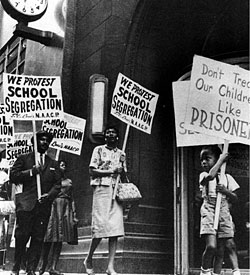|

In the United States, a majority of the South was affected by racial segregation in all public places such as buses, school,
and workplace. Beginning in the mid 1930's, the NAACP was bringing cases of the negative effects of segregation in schools
to the Supreme Court. One of the most well known cases was Brown v. the Topeka Board of Education.
During the summer of 1950, the Topeka, Kansas chapter of the NAACP was seeking parents that would participate in their
next case that would try to help deem segregation in schools unconstitutional. Thirteen parents volunteered to be a part of
the cases, most famous of them is Oliver Brown. The thirteen parents were: Oliver Brown, Darlene Brown, Lena Carper, Sadie
Emmanuel, Marguerite Emerson, Shirley Fleming, Zelma Henderson, Shirley Hodison, Maude Lawton, Alma Lewis, Iona Richardson,
and Lucinda Todd. All parents were instructed to attempt to enroll their elementary school aged children in to one of the
nearest all white schools as apposed to one of the four all black schools. All of the students were denied admission to the
schools, leaving an opportunity for the NAACP to make a presentable case.
As the twenty students were forced to attend schools that were a large distance from their house, the parents followed
instructions of the NAACP and filed a law suit against the Board of Education of Topeka, Kansas. When the case was presented
to the District Court in February of 1951, the court ruled in favor of the Board of Education citing the outcome of the Plessy
v. Ferguson which upheld the "separate but equal" law in all public facilities. The loss was not a shock to the
NAACP as they had had four other cases similar to Brown v. Board of Education fail in the district court.
In 1954 the NAACP brought all of the five cases, including Brown, together and presented them to the Supreme Court, all
represented by Thurgood Marshall, James Narbit, and George E. C. Hayes. In the first two rounds of arguments, known as Brown
I, the Supreme Court decided that racial segregation in public schools is a violation of the Equal Protection Clause of the
14th Amendment. During the third set of arguments, Brown II, the Supreme Court came to the final decision on May 17, 1954
that all schools should be desegregated as "soon as humanly possible" because segregation was deemed unconstitutional.
|
